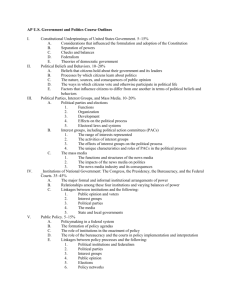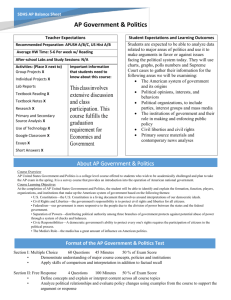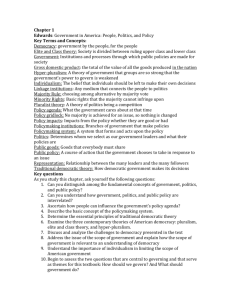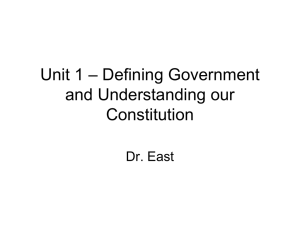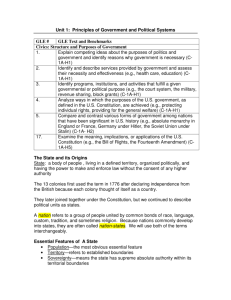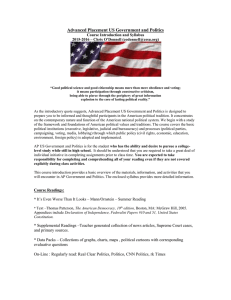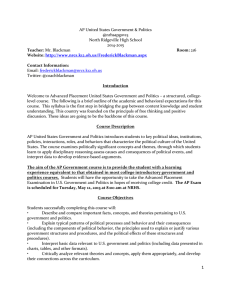Introducing Gov't in America
advertisement
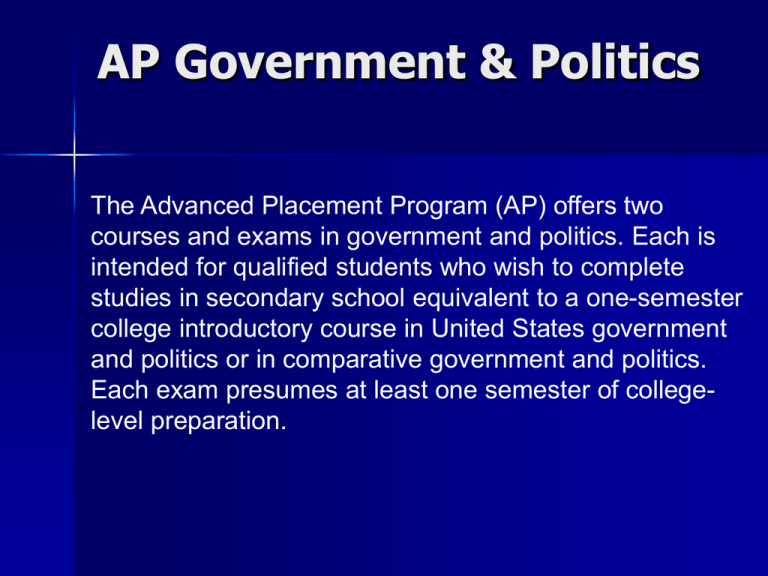
AP Government & Politics The Advanced Placement Program (AP) offers two courses and exams in government and politics. Each is intended for qualified students who wish to complete studies in secondary school equivalent to a one-semester college introductory course in United States government and politics or in comparative government and politics. Each exam presumes at least one semester of collegelevel preparation. AP U.S. Government A well-designed AP course in United States Government and Politics will give students an analytical perspective on government and politics in the United States. This course includes both the study of general concepts used to interpret U.S. government and politics and the analysis of specific examples. It also requires familiarity with the various institutions, groups, beliefs, and ideas that constitute U.S. government and politics. While there is no single approach that an AP United States Government and Politics course must follow, students should become acquainted with the variety of theoretical perspectives and explanations for various behaviors and outcomes. The AP United States Government and Politics Exam is 2 hours and 25 minutes long. It includes a 45minute multiple-choice section consisting of 60 questions and a 100-minute free-response section consisting of 4 questions. Units of Study 1. Foundations of American Government 2. Political Voices in America 3. Parties & Elections 4. Congress, President, Bureaucracy 5. Judiciary & Civil Liberties 6. Domestic & Foreign Policy Foundations of American Government Introduction to Government in America The Constitution Federalism Political Voices in America Public Opinion & Political Action Mass Media and the Political Agenda Interest Groups Parties & Elections Political Parties Nominations & Campaigns Elections & Voting Behavior Congress, President, Bureaucracy Congress Presidency Budget: Taxing & Spending Federal Bureaucracy Judiciary & Civil Liberties The Federal Courts Civil Liberties & Public Policy Civil Rights & Public Policy Domestic & Foreign Policy Economic Policymaking Social Welfare Policymaking Health Care & the Environment National Security LO 1.1 Age & Political Knowledge Today: Can you identify three domestic issues and where the President stands on them? Which political party controls the Senate? The House of Reps? Who are the: Secretary of State, Secretary of the Treasury, Attorney General? Can you identify three international issues that involve the U.S.? Who are the nine members of the Supreme Court? Any recent decisions by the Supremes? Government Definition: Government is the institutions and processes through which public policies are made for society. This definition leads to two basic questions: How should we govern? What should government do? Politics Definition: Politics is the process by which we select our governmental leaders and what policies they produce—politics produces authoritative decisions about public issues. Also consider Harold Lasswell’s definition: Who gets what, when and how. The Policymaking System Democracy Definition: Democracy is a system of selecting policymakers and of organizing government so that policy represents and responds to the public’s preferences. Components of Traditional Democratic Theory: Equality in voting Effective participation Enlightened understanding Citizen control of the agenda Inclusion Theories of U.S. Democracy Pluralist Elite Theory and Class Theory Hyperpluralism American Political Culture and Democracy Political Culture: An overall set of values widely shared within a society. American culture is diverse and comprised of: Liberty Egalitarianism Individualism Laissez-faire Populism How Active is American Government? It spends about $3.8 trillion annually It employs nearly 2.8 million civilians and 1.4 million in the military It owns one-third of the land It occupies 2.6 billion square feet of office space Questions about the Scope of Government Constitution and Federalism What role does the Constitution’s authors foresee for the federal government? Does the Constitution favor government with a broad scope? Why did functions of federal government increase? Has a more active government constrained or protected civil rights and liberties? Questions about the Scope of Government Public and Linkage Institutions Does the public favor a large, active government? Do competing political parties force government to provide more public services? Do elections control the scope of government? Does pressure from interest groups create a bigger government? Has the media helped control the size of government and its policies? Questions about the Scope of Government Elected Institutions Has the president been a driving force behind increasing the scope and power of government? Can the president control a large government? Is Congress predisposed to support big government? Is Congress too responsive to the public and interest groups? Questions about the Scope of Government Nonelected Institutions Are the federal courts too active in policy making, intruding on the authority of other branches of government? Is the bureaucracy constantly try to expand its budget or is it simply reflecting the desires of elected officials? Is the federal bureaucracy too large and thus wasteful and inefficient in the implementation of policy? Homework: 1. Print Syllabus for Unit 1 from website 2. Bring Summer Assignment to class
